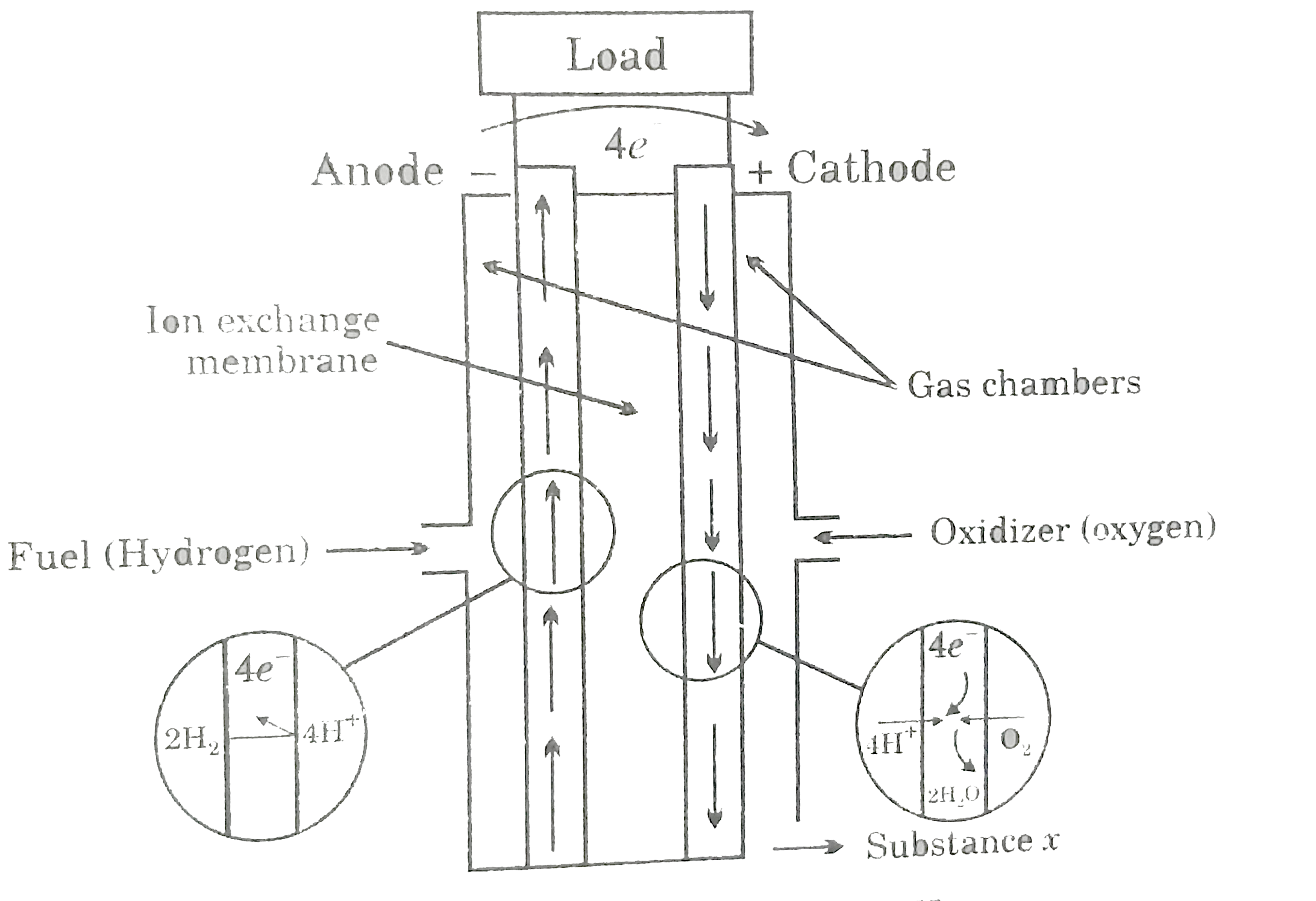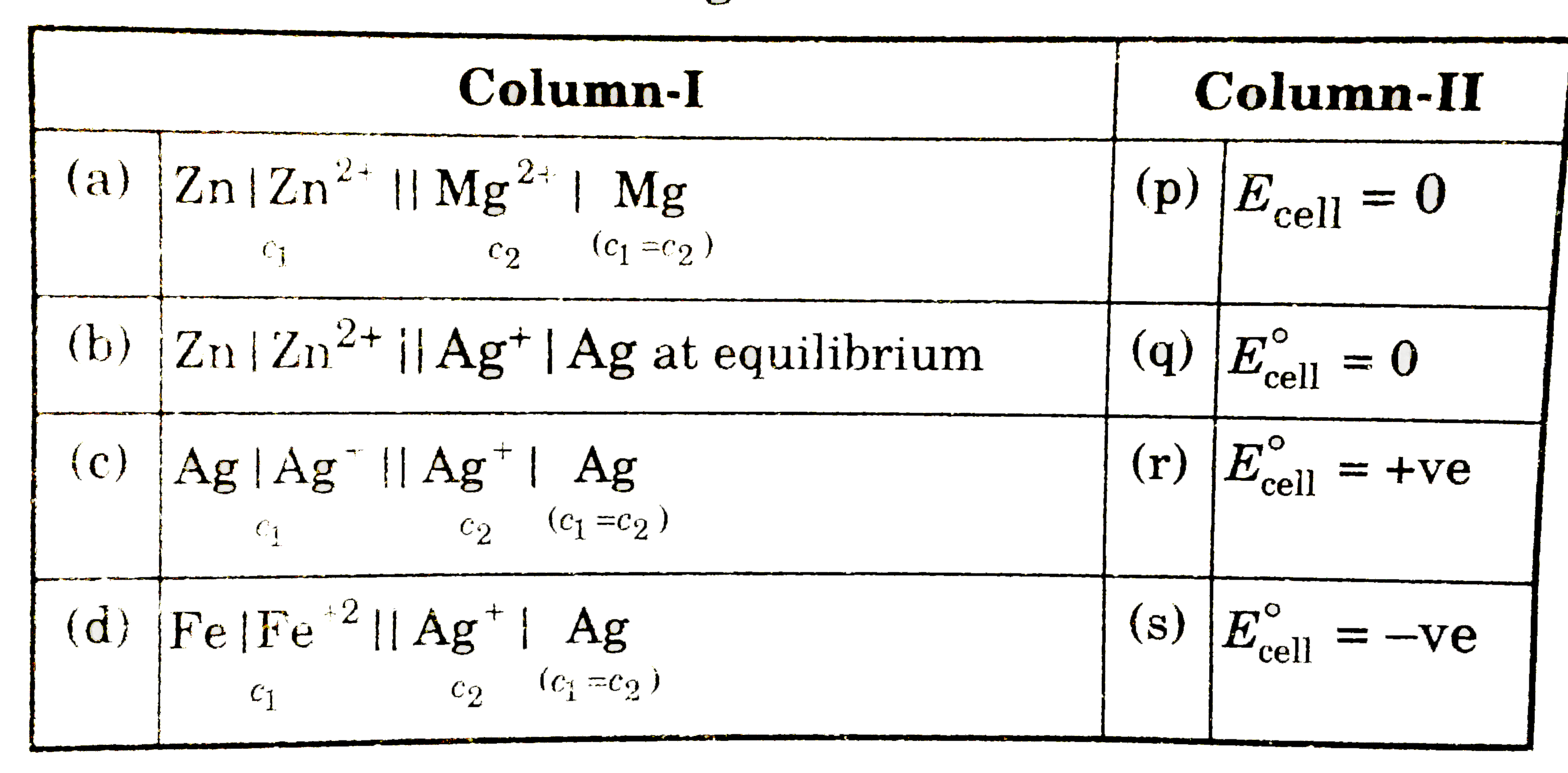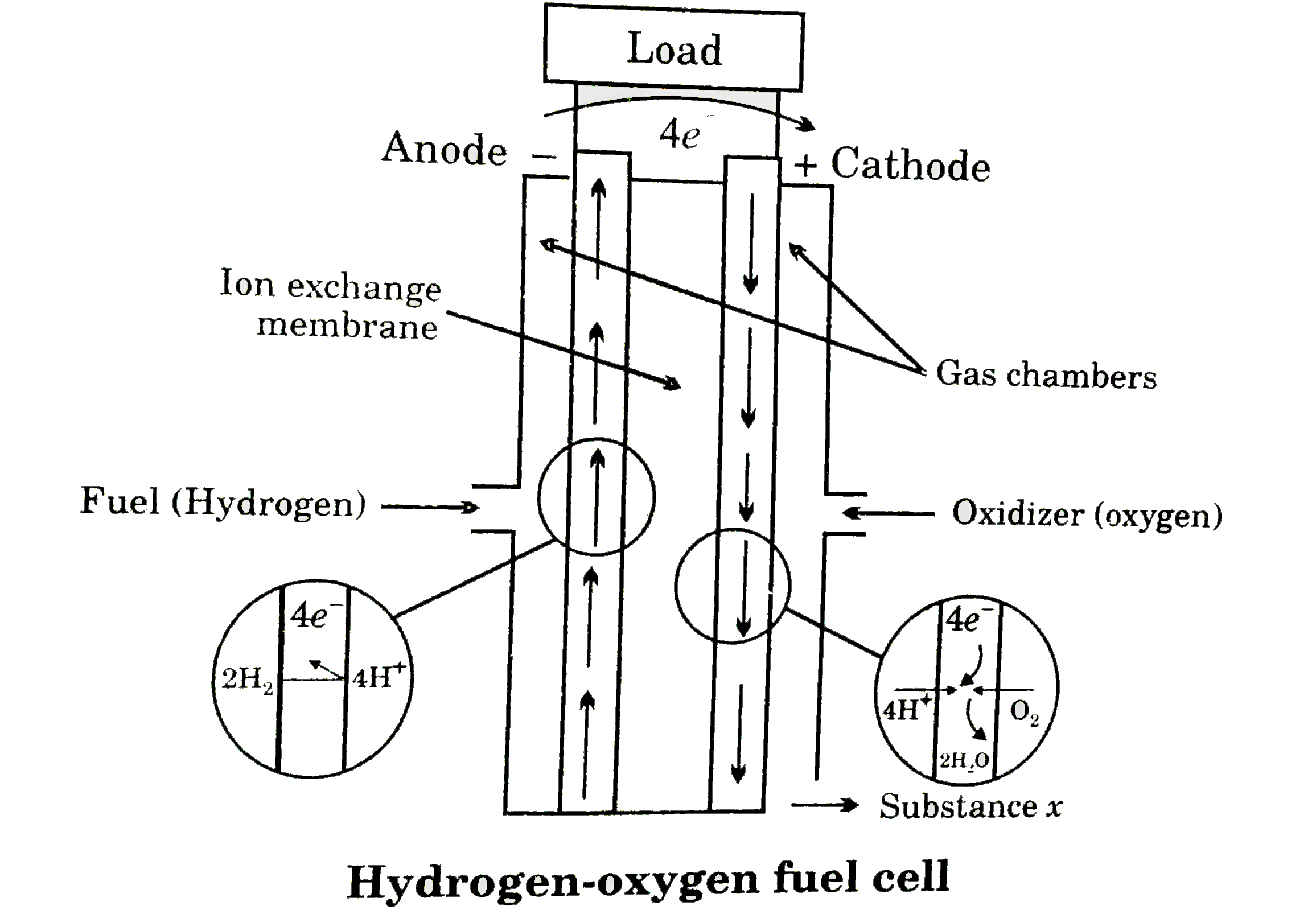A fuel cell is a cell that is continuously supplied with an oxidant and a reductant so that it can deliver a current indefinitely. Fuel cell offer the possibility of achieving high thermodynamic efficiency in the conversion of Gibbs energy into mechanical work. Internal combustion engines at best convert only the fraction (T2−T1)T2 of heat of combustion into mechanical work. While the thermodynamic efficiency of the fuel cell is give by, η=|ΔG||ΔH|, where ΔG is the Gibbs energy change for the cell reaction and ΔH is the enthalpy change of the cell reaction. This efficiency can be upto 80%-90% also in contrast to normal heat engine efficiency which are generally about 40%

Fuel cells may be classified according to the temperature range in wich they operate low temperature (25 to 100∘C), medium temperature (100 to 500∘C)), high temperature (500to1000∘C) and very high temperature is that catalyst for the various steps in the process are not so necessary. Polarization of a fuel cell reduces the current. Polarization is the result of slow reactions or processes such as diffusion in the cell. The figure indicates the construction of hydrogen-oxygen fuel cell with a solid electrolyte, which is an ion exchange membrane. The membrane is impermeable to the reactant gases, but is permeable to hydrogen ions, which carry the current between the electrodes. To facillitate the operation finely divided platinum that function as a catalyst. Water is drained out of the cell during operation. Fuel cells of this general type have been used successfully in the space program and are quite efficient. their disadvantages for large-scale commercial application are that hydrogen presetns storage problems, and platinum is an expensive catalyst. Cheaper catalysts have been found for higher temperature operatureof hydrogen-oxygen fuel cells. Fuel cells taht use hydrocarbons and air have been developed, but their power per unit weight is too low to make them practical in ordinary automobiles. Better catalysts are needed. A hydrogen-oxygen fuel cell may hae an acidic or alkaline electrolyte. The half-cell reactions are:
12O2(g)+2H++2e−→H2O(l)E∘=1.2288V
2H++2e−→H2(g)E∘=0
H2(g)+12O2(g)→H2O(l)E∘=1.2288V
or 12O2(g)+H2O(g)+2e−→2OH−E∘=0.4009V
2H2O(l)+2e−→H2(g)+2OH−E∘=−0.8279V
H2(g)+12O2(g)→H2O(l)E∘=1.2288V
To maximize the power per unit mass of an electrochemical cell, the electronic and electrolytic resistances of the cell must be minimized. than aqueous solutions, high-temperature electrochemical cells are of special interest for practical applications. High temperature also allow the use of liquid metal electrode, which makes possibel high current densities than solid electrodes.
What is the substance X taken out at bottom of the fuel cell shown in the figure?
H2O
H2O2
Both a and b
Neither
The correct Answer is:A
Step by step video, text & image solution for A fuel cell is a cell that is continuously supplied with an oxidant and a reductant so that it can deliver a current indefinitely. Fuel cell offer the possibility of achieving high thermodynamic efficiency in the conversion of Gibbs energy into mechanical work. Internal combustion engines at best convert only the fraction (T_(2)-T_(1))T_(2) of heat of combustion into mechanical work. While the thermodynamic efficiency of the fuel cell is give by, eta=(|DeltaG|)/(|DeltaH|), where DeltaG is the Gibbs energy change for the cell reaction and DeltaH is the enthalpy change of the cell reaction. This efficiency can be upto 80%-90% also in contrast to normal heat engine efficiency which are generally about 40% Fuel cells may be classified according to the temperature range in wich they operate low temperature (25 to 100^(@)C), medium temperature (100 to 500^(@)C)), high temperature (500 "to" 1000^(@)C) and very high temperature is that catalyst for the various steps in the process are not so necessary. Polarization of a fuel cell reduces the current. Polarization is the result of slow reactions or processes such as diffusion in the cell. The figure indicates the construction of hydrogen-oxygen fuel cell with a solid electrolyte, which is an ion exchange membrane. The membrane is impermeable to the reactant gases, but is permeable to hydrogen ions, which carry the current between the electrodes. To facillitate the operation finely divided platinum that function as a catalyst. Water is drained out of the cell during operation. Fuel cells of this general type have been used successfully in the space program and are quite efficient. their disadvantages for large-scale commercial application are that hydrogen presetns storage problems, and platinum is an expensive catalyst. Cheaper catalysts have been found for higher temperature operatureof hydrogen-oxygen fuel cells. Fuel cells taht use hydrocarbons and air have been developed, but their power per unit weight is too low to make them practical in ordinary automobiles. Better catalysts are needed. A hydrogen-oxygen fuel cell may hae an acidic or alkaline electrolyte. The half-cell reactions are: (1)/(2)O_(2)(g)+2H^(+)+2e^(-)rarrH_(2)O(l) E^(@)=1.2288V 2H^(+)+2e^(-)rarrH_(2)(g)E^(@)=0 H_(2)(g)+(1)/(2)O_(2)(g)rarrH_(2)O(l) E^(@)=1.2288V or (1)/(2)O_(2)(g)+H_(2)O(g)+2e^(-)rarr2OH^(-) E^(@)=0.4009V 2H_(2)O(l)+2e^(-)rarrH_(2)(g)+2OH^(-)E^(@)=-0.8279V H_(2)(g)+(1)/(2)O_(2)(g)rarrH_(2)O(l) E^(@)=1.2288V To maximize the power per unit mass of an electrochemical cell, the electronic and electrolytic resistances of the cell must be minimized. than aqueous solutions, high-temperature electrochemical cells are of special interest for practical applications. High temperature also allow the use of liquid metal electrode, which makes possibel high current densities than solid electrodes. What is the substance X taken out at bottom of the fuel cell shown in the figure? by Chemistry experts to help you in doubts & scoring excellent marks in Class 12 exams.
Topper's Solved these Questions
- BOOK - GRB PUBLICATIONCHAPTER - ELECTROCHEMISTYEXERCISE - Match the column type16videos
ELECTROCHEMISTY
- BOOK - GRB PUBLICATIONCHAPTER - ELECTROCHEMISTYEXERCISE - Subjective type39videos
ELECTROCHEMISTY
- BOOK - GRB PUBLICATIONCHAPTER - ELECTROCHEMISTYEXERCISE - Multiple objective type33videos
ELECTROCHEMISTY
- BOOK - GRB PUBLICATIONCHAPTER - D-BLOCK ELEMENTSEXERCISE - Subjective Type18videos
D-BLOCK ELEMENTS
- BOOK - GRB PUBLICATIONCHAPTER - ENVIRONMENTAL CHEMISTRY EXERCISE - Straight objective type40videos
ENVIRONMENTAL CHEMISTRY
Similar Questions
Mathc the following columns :
 02:12View Solution
02:12View SolutionThe conductivity ofa solution may be taken to be directly proportional to the total concentration of the charge carriers (ions) present in it in many cases. Using the above, find the percent decrease in conductivity (k) of a solution of a week monoacidic base BOH when its 0.1 M solution is diluted to double its original volume. (Kb=10−5forBOH)(takesqrt(50) = 7.07) (mark the answer to nearest integer)
15:12View SolutionWhich of the following statements is wrong about galvanic cells?
13:55View SolutionNumber of halide ions among (F−,Cl−,Br−,I−) which change their oxidation number on heating with MnO2+conc.H2CO4
14:15View SolutionWhich of the following cannot be degraded by natural processes ?
(P) DDT , (Q) Plastic materials
(R) Heavy metals , (S) Nuclear wastes12:48View SolutionThe efficiency of a fuel cell is given by:
02:12View SolutionA fuel cell is a cell that is continuously supplied with an oxidant and a reductant so that it can deliver a current indefinitely. Fuel cell offer the possibility of achieving high thermodynamic efficiency in the conversion of Gibbs energy into mechanical work. Internal combustion engines at best convert only the fraction (T2−T1)T2 of heat of combustion into mechanical work. While the thermodynamic efficiency of the fuel cell is give by, η=|ΔG||ΔH|, where ΔG is the Gibbs energy change for the cell reaction and ΔH is the enthalpy change of the cell reaction. This efficiency can be upto 80%-90% also in contrast to normal heat engine efficiency which are generally about 40%

Fuel cells may be classified according to the temperature range in wich they operate low temperature (25 to 100∘C), medium temperature (100 to 500∘C)), high temperature (500to1000∘C) and very high temperature is that catalyst for the various steps in the process are not so necessary. Polarization of a fuel cell reduces the current. Polarization is the result of slow reactions or processes such as diffusion in the cell. The figure indicates the construction of hydrogen-oxygen fuel cell with a solid electrolyte, which is an ion exchange membrane. The membrane is impermeable to the reactant gases, but is permeable to hydrogen ions, which carry the current between the electrodes. To facillitate the operation finely divided platinum that function as a catalyst. Water is drained out of the cell during operation. Fuel cells of this general type have been used successfully in the space program and are quite efficient. their disadvantages for large-scale commercial application are that hydrogen presetns storage problems, and platinum is an expensive catalyst. Cheaper catalysts have been found for higher temperature operatureof hydrogen-oxygen fuel cells. Fuel cells taht use hydrocarbons and air have been developed, but their power per unit weight is too low to make them practical in ordinary automobiles. Better catalysts are needed. A hydrogen-oxygen fuel cell may hae an acidic or alkaline electrolyte. The half-cell reactions are:
12O2(g)+2H++2e−→H2O(l)E∘=1.2288V
2H++2e−→H2(g)E∘=0
H2(g)+12O2(g)→H2O(l)E∘=1.2288V
or 12O2(g)+H2O(g)+2e−→2OH−E∘=0.4009V
2H2O(l)+2e−→H2(g)+2OH−E∘=−0.8279V
H2(g)+12O2(g)→H2O(l)E∘=1.2288V
To maximize the power per unit mass of an electrochemical cell, the electronic and electrolytic resistances of the cell must be minimized. than aqueous solutions, high-temperature electrochemical cells are of special interest for practical applications. High temperature also allow the use of liquid metal electrode, which makes possibel high current densities than solid electrodes.
If 567.5 mL of H2 gas at STP is fed into and is consumed by the cell in 10minutes, then what is the current output (in A) of the fuel cell?03:17View SolutionA fuel cell is a cell that is continuously supplied with an oxidant and a reductant so that it can deliver a current indefinitely. Fuel cell offer the possibility of achieving high thermodynamic efficiency in the conversion of Gibbs energy into mechanical work. Internal combustion engines at best convert only the fraction (T_(2)-T_(1))T_(2) of heat of combustion into mechanical work. While the thermodynamic efficiency of the fuel cell is give by, eta=(|DeltaG|)/(|DeltaH|) , where DeltaG is the Gibbs energy change for the cell reaction and DeltaH is the enthalpy change of the cell reaction. This efficiency can be upto 80%-90% also in contrast to normal heat engine efficiency which are generally about 40% Fuel cells may be classified according to the temperature range in wich they operate low temperature (25 to 100^(@)C ), medium temperature (100 to 500^(@)C) ), high temperature (500 "to" 1000^(@)C) and very high temperature is that catalyst for the various steps in the process are not so necessary. Polarization of a fuel cell reduces the current. Polarization is the result of slow reactions or processes such as diffusion in the cell. The figure indicates the construction of hydrogen-oxygen fuel cell with a solid electrolyte, which is an ion exchange membrane. The membrane is impermeable to the reactant gases, but is permeable to hydrogen ions, which carry the current between the electrodes. To facillitate the operation finely divided platinum that function as a catalyst. Water is drained out of the cell during operation. Fuel cells of this general type have been used successfully in the space program and are quite efficient. their disadvantages for large-scale commercial application are that hydrogen presetns storage problems, and platinum is an expensive catalyst. Cheaper catalysts have been found for higher temperature operatureof hydrogen-oxygen fuel cells. Fuel cells taht use hydrocarbons and air have been developed, but their power per unit weight is too low to make them practical in ordinary automobiles. Better catalysts are needed. A hydrogen-oxygen fuel cell may hae an acidic or alkaline electrolyte. The half-cell reactions are: (1)/(2)O_(2)(g)+2H^(+)+2e^(-)rarrH_(2)O(l) E^(@)=1.2288V 2H^(+)+2e^(-)rarrH_(2)(g)E^(@)=0 H_(2)(g)+(1)/(2)O_(2)(g)rarrH_(2)O(l) E^(@)=1.2288V or (1)/(2)O_(2)(g)+H_(2)O(g)+2e^(-)rarr2OH^(-) E^(@)=0.4009V 2H_(2)O(l)+2e^(-)rarrH_(2)(g)+2OH^(-)E^(@)=-0.8279V H_(2)(g)+(1)/(2)O_(2)(g)rarrH_(2)O(l) E^(@)=1.2288V To maximize the power per unit mass of an electrochemical cell, the electronic and electrolytic resistances of the cell must be minimized. than aqueous solutions, high-temperature electrochemical cells are of special interest for practical applications. High temperature also allow the use of liquid metal electrode, which makes possibel high current densities than solid electrodes. For a hydrogen-oxygen fuel cell if DeltaH_(f)^(2)(H_(2)O,l)=-285kJ//""mole"" , then what will be its thermodynamic efficiency under standard conditions (use data given in the passage if required)?
01:35View SolutionA fuel cell is a cell that is continuously supplied with an oxidant and a reductant so that it can deliver a current indefinitely. Fuel cell offer the possibility of achieving high thermodynamic efficiency in the conversion of Gibbs energy into mechanical work. Internal combustion engines at best convert only the fraction (T_(2)-T_(1))T_(2) of heat of combustion into mechanical work. While the thermodynamic efficiency of the fuel cell is give by, eta=(|DeltaG|)/(|DeltaH|) , where DeltaG is the Gibbs energy change for the cell reaction and DeltaH is the enthalpy change of the cell reaction. This efficiency can be upto 80%-90% also in contrast to normal heat engine efficiency which are generally about 40% Fuel cells may be classified according to the temperature range in wich they operate low temperature (25 to 100^(@)C ), medium temperature (100 to 500^(@)C) ), high temperature (500 "to" 1000^(@)C) and very high temperature is that catalyst for the various steps in the process are not so necessary. Polarization of a fuel cell reduces the current. Polarization is the result of slow reactions or processes such as diffusion in the cell. The figure indicates the construction of hydrogen-oxygen fuel cell with a solid electrolyte, which is an ion exchange membrane. The membrane is impermeable to the reactant gases, but is permeable to hydrogen ions, which carry the current between the electrodes. To facillitate the operation finely divided platinum that function as a catalyst. Water is drained out of the cell during operation. Fuel cells of this general type have been used successfully in the space program and are quite efficient. their disadvantages for large-scale commercial application are that hydrogen presetns storage problems, and platinum is an expensive catalyst. Cheaper catalysts have been found for higher temperature operatureof hydrogen-oxygen fuel cells. Fuel cells taht use hydrocarbons and air have been developed, but their power per unit weight is too low to make them practical in ordinary automobiles. Better catalysts are needed. A hydrogen-oxygen fuel cell may hae an acidic or alkaline electrolyte. The half-cell reactions are: (1)/(2)O_(2)(g)+2H^(+)+2e^(-)rarrH_(2)O(l) E^(@)=1.2288V 2H^(+)+2e^(-)rarrH_(2)(g)E^(@)=0 H_(2)(g)+(1)/(2)O_(2)(g)rarrH_(2)O(l) E^(@)=1.2288V or (1)/(2)O_(2)(g)+H_(2)O(g)+2e^(-)rarr2OH^(-) E^(@)=0.4009V 2H_(2)O(l)+2e^(-)rarrH_(2)(g)+2OH^(-)E^(@)=-0.8279V H_(2)(g)+(1)/(2)O_(2)(g)rarrH_(2)O(l) E^(@)=1.2288V To maximize the power per unit mass of an electrochemical cell, the electronic and electrolytic resistances of the cell must be minimized. than aqueous solutions, high-temperature electrochemical cells are of special interest for practical applications. High temperature also allow the use of liquid metal electrode, which makes possibel high current densities than solid electrodes. Why are fuel cells not being used in daily life depite their very high efficiency?
View SolutionA fuel cell is a cell that is continuously supplied with an oxidant and a reductant so that it can deliver a current indefinitely. Fuel cell offer the possibility of achieving high thermodynamic efficiency in the conversion of Gibbs energy into mechanical work. Internal combustion engines at best convert only the fraction (T_(2)-T_(1))T_(2) of heat of combustion into mechanical work. While the thermodynamic efficiency of the fuel cell is give by, eta=(|DeltaG|)/(|DeltaH|) , where DeltaG is the Gibbs energy change for the cell reaction and DeltaH is the enthalpy change of the cell reaction. This efficiency can be upto 80%-90% also in contrast to normal heat engine efficiency which are generally about 40% Fuel cells may be classified according to the temperature range in wich they operate low temperature (25 to 100^(@)C ), medium temperature (100 to 500^(@)C) ), high temperature (500 "to" 1000^(@)C) and very high temperature is that catalyst for the various steps in the process are not so necessary. Polarization of a fuel cell reduces the current. Polarization is the result of slow reactions or processes such as diffusion in the cell. The figure indicates the construction of hydrogen-oxygen fuel cell with a solid electrolyte, which is an ion exchange membrane. The membrane is impermeable to the reactant gases, but is permeable to hydrogen ions, which carry the current between the electrodes. To facillitate the operation finely divided platinum that function as a catalyst. Water is drained out of the cell during operation. Fuel cells of this general type have been used successfully in the space program and are quite efficient. their disadvantages for large-scale commercial application are that hydrogen presetns storage problems, and platinum is an expensive catalyst. Cheaper catalysts have been found for higher temperature operatureof hydrogen-oxygen fuel cells. Fuel cells taht use hydrocarbons and air have been developed, but their power per unit weight is too low to make them practical in ordinary automobiles. Better catalysts are needed. A hydrogen-oxygen fuel cell may hae an acidic or alkaline electrolyte. The half-cell reactions are: (1)/(2)O_(2)(g)+2H^(+)+2e^(-)rarrH_(2)O(l) E^(@)=1.2288V 2H^(+)+2e^(-)rarrH_(2)(g)E^(@)=0 H_(2)(g)+(1)/(2)O_(2)(g)rarrH_(2)O(l) E^(@)=1.2288V or (1)/(2)O_(2)(g)+H_(2)O(g)+2e^(-)rarr2OH^(-) E^(@)=0.4009V 2H_(2)O(l)+2e^(-)rarrH_(2)(g)+2OH^(-)E^(@)=-0.8279V H_(2)(g)+(1)/(2)O_(2)(g)rarrH_(2)O(l) E^(@)=1.2288V To maximize the power per unit mass of an electrochemical cell, the electronic and electrolytic resistances of the cell must be minimized. than aqueous solutions, high-temperature electrochemical cells are of special interest for practical applications. High temperature also allow the use of liquid metal electrode, which makes possibel high current densities than solid electrodes. The advantage of using fuel cell in a motorcar could be:
View SolutionThe efficiency of a fuel cell is given by:-
04:19View SolutionT1,T2 ताप के बीच कार्य कर रहे कानों इंजन की दक्षता होती है
05:03View Solutionईंधन सेल की दक्षता क्या है ?
03:20View SolutionName the cells that convert the energy of combustion of fuels into electrical energy.
View SolutionWhat is the efficiency of working of fuel cells ?
03:55View Solution

